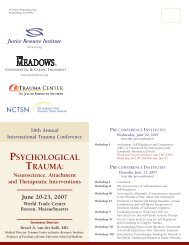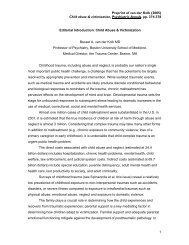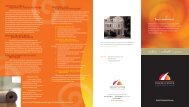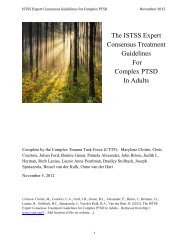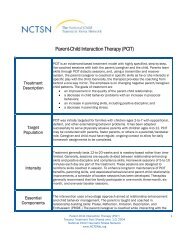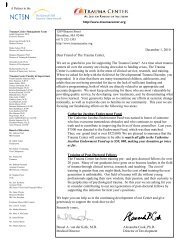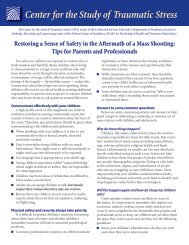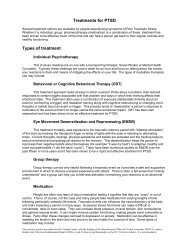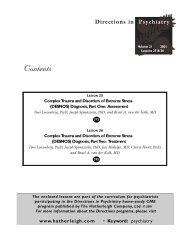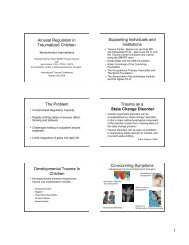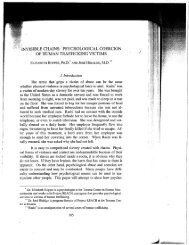in Child Welfare - The Trauma Center
in Child Welfare - The Trauma Center
in Child Welfare - The Trauma Center
Create successful ePaper yourself
Turn your PDF publications into a flip-book with our unique Google optimized e-Paper software.
Recent studies show that as many as 702,000youth <strong>in</strong> care were identified as maltreatmentvictims (USDHHS, 2009) and that formany children <strong>in</strong> care there is a reciprocalrelationship found between behavior problemsand placement changes (Aarons et al., 2010).<strong>The</strong>se studies suggest a need for more effective<strong>in</strong>terventions target<strong>in</strong>g children’s behavioralong with better tra<strong>in</strong><strong>in</strong>g and support forresource parents (<strong>in</strong>clud<strong>in</strong>g foster, adoptive,therapeutic, and k<strong>in</strong>ship) <strong>in</strong> order to managechildren’s emotional and behavioral problemsand to <strong>in</strong>crease placement stability.<strong>The</strong> <strong>Child</strong> <strong>Welfare</strong> workgroup with<strong>in</strong> <strong>The</strong>National <strong>Child</strong> <strong>Trauma</strong>tic Stress Network(NCTSN; www.nctsn.org) developed andpiloted a new tool to help address the needfor tra<strong>in</strong><strong>in</strong>g and support of resource parents.This tool is called Car<strong>in</strong>g for <strong>Child</strong>ren WhoHave Experienced <strong>Trauma</strong>: A Workshopfor Resource Parents, also referred to as theResource Parent Curriculum (RPC). RPC wasdeveloped to help resource parents who maybe parent<strong>in</strong>g children with complex traumahistories and equally complex behaviors andemotions.At the <strong>Center</strong> for <strong>Child</strong> and Family Health(CCFH), we began facilitat<strong>in</strong>g RPC as partof our proposal to SAMHSA for our NCTSNCommunity Treatment Services <strong>Center</strong> grant.Our ma<strong>in</strong> goals <strong>in</strong> select<strong>in</strong>g RPC were to:1. help resource parents understand howexposure to traumatic <strong>in</strong>cidents as wellas placement disruptions can impactchildren’s emotions and behavior,2. provide concrete strategies for parents touse with children <strong>in</strong> their home,3. help parents try to depersonalize some oftheir child’s reactions to trauma rem<strong>in</strong>ders,and4. educate parents to advocate for theirchildren need<strong>in</strong>g trauma-focusedtreatments. Our staff facilitators wereselected based on their extensive experience<strong>in</strong> tra<strong>in</strong><strong>in</strong>g other professionals toimplement evidence based treatments forchild trauma victims and their families.CW360 o <strong>Trauma</strong>-Informed <strong>Child</strong> <strong>Welfare</strong> Practice • W<strong>in</strong>ter 2013 33Lessons Learned from Implement<strong>in</strong>g the ResourceParent<strong>in</strong>g Curriculum with Foster and Adoptive ParentsGeorge S. Ake III, PhDWhile we understood the value of RPC andbelieved that it was well designed, I am notcerta<strong>in</strong> that any of us really were preparedfor the magnitude of positive changes thatit would soon br<strong>in</strong>g. Here are a few of thelessons we learned from resource parents,child welfare workers, and our tra<strong>in</strong><strong>in</strong>gfaculty.Resource ParentsOverall, resource parents taught us that their<strong>in</strong>volvement <strong>in</strong> RPC helped them understandhow approach<strong>in</strong>g problem behaviors witha trauma lens was more effective than theirprevious approaches. <strong>The</strong>y commentedthat they wished they had participated<strong>in</strong> RPC earlier and that resource parentsshould be required to complete this tra<strong>in</strong><strong>in</strong>gas part of their <strong>in</strong>-service requirementsgiven the number of children <strong>in</strong> care withtrauma histories and the perceived lack of<strong>in</strong>formation about how to address it. Whileparents came <strong>in</strong> with very different levelsof <strong>in</strong>formation and understand<strong>in</strong>g abouttheir children’s history, most of them leftthe group hav<strong>in</strong>g a greater appreciation forhow children’s experiences could impacttheir current behavior. In addition, parentsgenerally reported that participat<strong>in</strong>g <strong>in</strong> RPChelped to alleviate their feel<strong>in</strong>gs of isolationand frustration while help<strong>in</strong>g to empowerthem to advocate for trauma-<strong>in</strong>formedservices for their family.Parents reported see<strong>in</strong>g positive changes<strong>in</strong> their day-to-day approach to parent<strong>in</strong>g andmany attributed this change to adjustmentsthey made to accommodate their children’strauma histories. For example, one couplewithdrew their child from water sportsdue to their new understand<strong>in</strong>g of traumatriggers and their child’s history of hav<strong>in</strong>gprevious caregivers who used water as partof their abusive discipl<strong>in</strong>e. Another couplefelt like they had failed as parents of anadopted adolescent prior to RPC, but felt“enlightened” and more hopeful at the endof the group because they understood howtheir child’s complex trauma history mightbe connected to difficulties establish<strong>in</strong>grelationships with others. <strong>The</strong>y also reportedthat meet<strong>in</strong>g other parents with similarsituations was encourag<strong>in</strong>g throughout thegroup and, hopefully, follow<strong>in</strong>g the group.<strong>Child</strong> <strong>Welfare</strong> Professionals<strong>The</strong> North Carol<strong>in</strong>a Division of SocialServices (DSS) has been a tremendous partner<strong>in</strong> mak<strong>in</strong>g RPC a possibility for resourceparents as part of a larger effort to make NC’schild welfare system more trauma-<strong>in</strong>formed.Many of these groups were held <strong>in</strong> countyDSS offices, and the workers who werepresent for the groups commented that RPCmade a difference and that they benefittedfrom hear<strong>in</strong>g how to talk with parents abouttrauma.Resource Parent Curriculum was developed to help resource parentswho may be parent<strong>in</strong>g children with complex trauma histories andequally complex behaviors and emotions.Tra<strong>in</strong><strong>in</strong>g FacultyAfter implement<strong>in</strong>g this curriculum once <strong>in</strong>an eight-week group format with a trauma<strong>in</strong>formedmental health cl<strong>in</strong>ician and a fosterparent or foster care alumni co-facilitator,we all were positive that this was the bestplatform to serve resource parents. Eachgroup we have done has been more successfulthan the last as we have <strong>in</strong>corporated qualityimprovement activities and built on lessonslearned. Currently, CCFH has a full timeRPC tra<strong>in</strong>er and through various fund<strong>in</strong>gsources plans on hav<strong>in</strong>g completed a total of57 groups between 2011 and 2016.George S. Ake III, PhD is an AssistantProfessor <strong>in</strong> the Department ofPsychiatry and Behavioral Sciences atDuke University Medical <strong>Center</strong> and theAssistant Tra<strong>in</strong><strong>in</strong>g Director at the <strong>Center</strong>for <strong>Child</strong> and Family Health <strong>in</strong> Durham,North Carol<strong>in</strong>a. Dr. Ake can be reachedat george.ake@duke.edu.Perspectives




